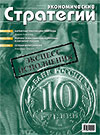Negative stability
The paper considers changes of the “Economic Strategies” opportunistic index (OIES) in January-September 2014. The contribution of supply and demand indices into OIES is estimated. Industrial production analysis is performed.

The paper considers changes of the “Economic Strategies” opportunistic index (OIES) in January-September 2014. The contribution of supply and demand indices into OIES is estimated. Industrial production analysis is performed.
The play of how the nearest entourage of the head of state, political and military elite, the main support of the Emperor Nicholas II organized a plot in the crucial year of the First World War, when the Russian Empire was a stone’s throw away from victory.
In 1989 Eastern Europe was jumping for joy and thanking Gorbachev. Perhaps he seemed to us a naive talker from the Politburo, but one thing is true: if not for perestroyka, we still would be walking crouched, waiting for the storm to pass (by Zhivkov) and along the Berlin Wall (by Honecker).
The role of “Minskmetroproekt” in solving transport problems of the Belarusian capital is indisputable. The company became a pioneer of the new road in Minsk – underground. Today the Minsk subway carries more than a third of all the capital passengers, and by all standards, norms and parameters applied to facilities of this type, is recognized as one of the most comfortable and safest in the world. This is a kind of “ring” unifying man and the city. To avoid damaging the architectural ensemble of Minsk, tunneling and stations construction were carried out with a high degree of reliability and accuracy. There is one construction mode, characteristic for Minsk – station space zoning into transport and passengers areas. But it doesn’t level the stations architecture, on the contrary – it combines a variety of colors and interior plastic solutions. In his interview with the “ES” General Director of JSC “Minskmetroproekt”, “Man of the Year 2014” award winner Valery Chekanov told about unique, one-of-a-kind institute, which developed the projects for all currently existing lines of the Minsk subway, new lines are still being designed and put into operation on the basis of its projecting.
Network nonhierarchical structures have sufficiently significant potential in business, where they correspond to strategic alliances between firms, inter-firm networks of its autonomous departments, as well as to small network companies, the typical example of which is represented by manufacturing cooperatives. Not less prospects characterize decentralized networks in the political sphere, where we see such important examples as inter-state network alliances, cross-border and global network organizations and movements, advisory commissions and committees under the state apparatus structures and especially network structures being part of the largely non-hierarchical civil society, expressing the citizens’ will and interests in their dialogue with the political system’s hierarchy. On the basis of presented facts the author makes a conclusion that networks in economy contribute to implement the principles of self-managed socialism, and in political sphere – to implement the principles of new type meritocracy, which will be supported by civil society network structures.
The paper proposes an approach that gives a scientific character to the concept of network-centric management, and considered systemic paradigms allow to consider it as an engineering construction. It proposes the concept and management contour models of the first and the second kind, revealing communities’ management mechanisms and processes of their self-organization. They represent not only new opportunities, but also unfamiliar threats. Only basic knowledge of socio-engineering will help to build a security system, to ensure the survival and development of society. However, given any methodological complexity the human factor plays a decisive role. Management of complex systems requires self-dependence, intelligence coordination and real time actions, the synergy of knowledge, intuition and participants’ sagacity as well as harmonious interaction with the environment, including society.
Presentation of specific information in a human brain as a hierarchy of events, dictionaries, images of different occurrence frequencies and of different modalities is a model of the human world, consisting of three components – the individual multimodal right-hemispheric (right-handers) and two socialized left-hemispheric – multimodal and linguistic, which to some extent are (all) isomorphic to each other. Perhaps, a person’s mentality is determined by his model of the world. Maybe, comparing the world models (their linguistic components) of individuals it will be possible to understand the degree of their mentality closeness. Therefore, we can try to interpret the mentality of the texts’ authors on the basis of their texts. Comparing texts of the members of different “network” communities (closeness inside, difference between them), we’ll be possibly able to find out the principles of people’s unification in these communities.
The second part of the paper shows the degradation stages of modern society and analyzes social phenomena caused by nonspecific metafactors. And, although there is still a lack of cultural-historical and scientific experience for their understanding, one thing is clear — restoration of system genesis progress should begin with restoration of the moral-ethical semantic structures on the psycho-social level of systemic organization.